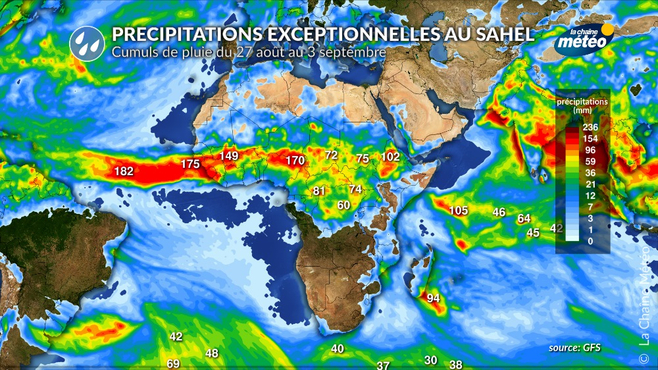Rare rainy episode in the Sahara: Up to 5 months of rain expected
Heavy rains flooded the Arbaat area north of Port Sudan in the Red Sea State on Saturday, causing a dam to collapse and killing more than 130 people. The exceptional rains will also affect part of the southern Sahara (the Sahel) in the coming days.
Desert: desert climate
The Sahara Desert, which covers more than 9.2 million square kilometers, is mostly dry due to a subtropical high pressure system that prevents rainfall. However, a few thousand years ago, this region was green and full of lakes and rivers before becoming a desert due to global climate change.
The tropical rain belt near the equator, called Intertropical Convergence Zone (ITCZ)It greatly affects the climate of tropical countries and can also influence the formation of tropical storms. Currently, it has moved north, bringing rare rainfall to the desert. This shift may also have implications for the Atlantic hurricane season.
Several months of rain is expected over the next 15 days.
 Exceptional rains in the Sahel region © The Weather Channel
Exceptional rains in the Sahel region © The Weather Channel
Normally, more than half of the Sahara Desert receives less than 25 mm of rainfall per year. However, the latest weather forecasts suggest heavy rains covering much of the desert over a two-week period, with some areas receiving several months’ worth of rain in a few days. In some places, up to 500% of the rainfall normally experienced in late August and early September, or locally the equivalent of 5 years’ worth of rain, is expected. This type of event has a return period of around 10 years, making it exceptional.
Such weather events highlight potential instability in the global climate system. While the Sahel experienced frequent severe droughts in the 1980s, in recent years we have seen more rainy monsoons in this tropical region. Remember, the Sahara was green and had lakes 7,000 years ago. More research is underway to understand the potential impacts of these anomalies on fall or winter climates in the United States and Europe.
